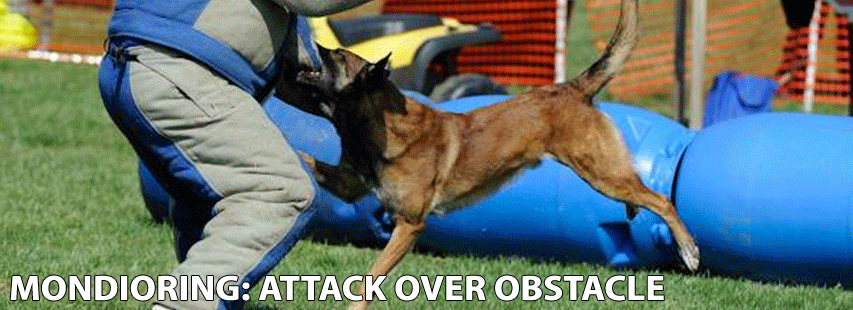Face Attack with Baton
Level I: Without obstacle
Levels II & III: With obstacle
Breakdown of points
| Start | 10 points |
| Attack | 30 points in Level I & III 20 in Level II) |
| End and Recall | 10 points |

PENALTIES:
Second offense of start before Judge’s signal
Starting after the Judge’s signal before command.
Additional commands to attack (only 1 allowed) : if dog leaves at first command, no additional commands are allowed
Any irregular behaviour before or during the exercise
Per second not biting
Per rapid change in bite
Per second biting after out command (1 second allowance)
Additional bite after end of exercise
Additional recall command (only one is allowed)
Not biting at the time of recall (plus per second not biting)
Failure to return within 30 seconds
Any irregular behaviour after end of exercise
Dog does not attack or does not bite
(the dog cannot execute a Stopped Attack
or will lose the points gained in that attack if already executed)
Handler leaves starting line during the exercise (a lateral movement behind the line is allowed if needed to see his dog, but he must remain motionless after the out command)
Handler uses the course for training.
Dog hesitates in front of the obstacle (Deduction from start points).
Dog bypasses the obstacle (not penalized on return) (Deduction from “bite” points)
Dog creeps forward at the start line -1 per meter
Dog stops biting at the judge’s horn and returns to handler
| Duration | 10 seconds |
| Distance Level I | 30 m |
| Distance Level II | 40 m |
| Distance Level III | 50 m |
Allowed: Barrage, threats, intimidation, charging at the dog (2 steps maximum), avoiding during the attack if the dog loses its bite. An accessory may be used in place of the baton during the attack with obstacle. In Level I, only the stick is allowed. In Level I, the arms must be accessible for the dog to bite.
Forbidden: Avoiding at the entry, striking the dog, any gesture or behaviour of the Decoy which may cause pain to the dog – if this happens, the Decoy is removed from the field immediately and may be reported.
Obstacles:
– Moat or plastic water tub, maximum water depth 20 cm.
– Hay bales
– Tires, piled up or placed upright
– Bands fastened vertically to a crossbar
– Netting
Obstacles must not be more than 80 cm wide, except for water obstacles, or flat obstacles that have a maximum of 25 cm in height. The tires, hay bales, and the netting must not exceed 80 cm in height. The length of the obstacles will be 8 to 10 m and must permit the Judges to evaluate the attitude of the dog as it approaches the attack. No obstacle must injure the dog or do it any harm. In the spirit of this exercise, the obstacle is meant to slow the dog down in order to judge his courage in the face of an accessory or baton, and it should never present any danger. The Decoy places himself 5 m behind the obstacle at the midpoint of its length.
Cross beams (poles) can be placed above the obstacle the Decoy has to show himself in front of the obstacle and then remain visible at all times to the dog.
So that there will never be any confusion regarding the spirit of the dog, we ask it to attack the Decoy. The decoy must signal his presence. The decoy must present himself/herself clearly for the first 10 m that the dog runs in order to draw the dog’s attention to the decoy. For the Face Attacks, the decoy must attract the dog with the stick. If need be, the Judge will send the Decoy out 10 to 20 m, then authorize the dog to be sent out as soon as the Decoy is behind the obstacle. To take his place, the Decoy must clear the obstacle each time, whenever possible.
The Decoy should place himself at least 5 m behind the obstacle. He must not charge the dog while it is in the air. If he wants to charge the dog, he must adjust the distance to maintain the 5 m distance from the obstacle.
For each attack, the decoy must absorb the dog while maintaining the line of attack. Avoiding is not allowed on entry. If the absorbing movement is too anticipated, it becomes an involuntary avoidance by the decoy. If this happens, one should not count the delayed time to bite.
The Decoy will not stop moving until the command to end the exercise, then he must immediately become absolutely still.
For all attacks, once the decoy has started to work at the signal of the judge, and the handler gives another stabilization command (voice or gesture), it will be considered as avoiding early departure and penalized -10 for the start, -5 for GA; and the dog has to start again.
For all attacks, a dog not biting at time of recall, or returns before the judge’s signal, loses 10pts for the return (plus points associated with seconds not biting).
For all attacks, a dog that is not biting at the end of the exercise, but is trying to regain the bite, and whose handler recalls the dog on the judge’s signal will lose 5 points for the return (plus points associated with seconds not biting).
Dogs that stop biting at the judge’s horn and returns to handler will lose 5 points for the return.
For all attacks, a dog that creeps forward at the start line will lose -1 per meter up to 10 meter: it is considered an early departure before authorization of the judge and thus penalized.